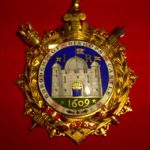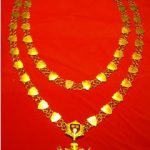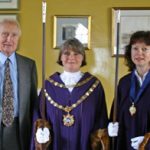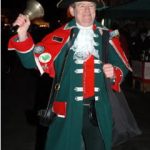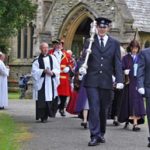The town regalia comprises the mayor’s chain of office and a pendant worn by the deputy mayor. They are worn in public at the Mayor Making, the Mayor’s Sunday procession, Remembrance Sunday and any other formal Town Council occasions. The heart shaped gold shields bear the names and dates of the mayors of Bishop’s Castle. They have to be individually made and in 2007
the council agreed to have a small number made and work done to the chain to make it more wearable. Because the shields are solid gold, the chain is very heavy.
The Town Council also has 2 very fine silver maces and 2 ancient halberds (pikes) thought to have come from the castle. These are carried in front of the mayor on processions by the town’s mace and pike bearers. The town crier also has a staff. The Mayor’s Sunday procession is traditionally led by the town’s Drum and Bugle Band (pictured below in 2005 starting off from the Town hall).
The town crier also usually takes part in the procession and in many other of the town’s festivals and events.
Both the mayor and the deputy have staffs. or “staves of office”. They are pictured here in 2005 in the hands of Cllrs. Jane Carroll (Mayor) and Julie Magill. With them is former mayor and long serving councillor Dr. St. John Penney.
The mace bearers, lead the mayoral procession away from the parish church of St. John the Baptist following the Mayor’s Sunday service.
BISHOP’S CASTLE MACES AND SEAL
There are two silver maces, each 3ft 7ins. long, therefore the largest in Shropshire. There are not many finer ones (if any) among the very complete collection of copies at South Kensington, though there are one or two larger ones. They have crowned heads, with orb and cross; the shafts are chased with oak branches and acorns, and the dividing knots (Knops?) with oak leaves. On top of the heads, which are supported by four brackets, are the Royal Arms of William III. The heads are divided into four panels by armless caryatides, which also separate the initial letters “W” and “R”. In the panels are the usual badges: (1) Rose, (2) Thistle, (3) Fleur-de-lys, (4) Harp, all crowned. On the footknops are the Arms of the Marquess of Powys, with motto “Loyal in adversity”, and also a representation of the Common Seal of the Borough, with the date 1698, but the centre dome dividing the initial letters “W” and “R” instead of “I” and “R” as on the Seal. Hall Marks: London, 1697-8. Maker Anthony Nelme. I cannot explain the date on the hall marks, as it appears from the Coronation Minutes that in 1608 a “Lewne” or Rate was levied to purchase the Maces.
It appears that William Herbert, Earl of Powys, was created “Viscount Montgomery and Marquess of Powys” in 1687 by James II. The latter title became extinct in 1784.
A handsome oak box, lined with blue velvet, was purchased by subscription in 1897, and contains the Maces, the Criers Staff, and Seal. The Maces, which were in a bad state, were repaired at the same time.
THE CORPORATION SEAL is 3.75 ins. long, including the ivory handle. It is mentioned here because it was made out of the old Maces. The device is an embattled gateway with portcullised entrance flanked by two domed round towers, and surmounted by a large dome, with the letters “I R” (for Jacobus Rex) on either side. From each of the domes flies a pennon. In the base is a date 1609. There is no legend. This date 1609 must have been the date of manufacture, and tallies with the date 1608 in the Minutes, when the Rate was levied to pay for the new Maces. Unfortunately, this date 1609 is reproduced on all copies of the Corporation Seal, and gives a wrong impression, because the Charter of Elizabeth was 1573, and was probably not the first Charter of the Town. The Seal was enrolled in the Herolds College but it does not constitute a Coat of Arms.
CRIER’S STAFF (of lignam vitae) with Arms of William III on top. The silver band has the makers name A Je (for Anthony Nelme who made the maces). On a shield at the bottom of the foot knop are the following Arms and crest, possibly of the donor:- The Arms are a lion rampant quadrant. The Somerset Herald stated these were the arms of Mason. Robert Mason was the first Bailliff in 1573 under Elizabeth’s Charter.
STAVES OF OFFICE (2) borne by Mayor and ex Mayor 6 ft 2 ins long with silver heads showing the Borough Seal. The Mayors staff is said to be mahogany the silver being 5 ins deep. The ex-Mayor’s staff is of a much lighter wood and only 4.5 ins of silver.
HALBERDS (2) Ash poles 6ft 4 ins and 5 ft 10ins long with steel heads, carried before the macebearers. There is no record of their origin but quite probably they were part of the Armoury of the Castle, which has a complement of six halberds.
MAYOR’S CHAIN of gold made by Bragg, the centre shield is the Arms of Shrewsbury at one time often used for Arms of the County. The pendant badge is the Borough Seal in enamel with an inscription on the back of its origin. Each Mayor adds a shield to record his year of office.
THE MAYOR’S BADGE with the Borough Seal in enamel presented by Ald. E. Griffiths (ex Town Clerk) during his Mayoralty.
History of the Town Hall by Patricia Theobold of the Bishop’s Castle Heritage Resource Centre
THE TOWN HALL BISHOP’S CASTLE SHROPSHIRE
Preliminary searches for documentary evidence of its structure and use
Introduction
Bishop’s Castle Shropshire lies about twenty miles southwest of the county town of Shrewsbury (SO 323 888). It has been a central place in the Marches for centuries. The castle was built between 1085-1100 by the Bishops of Hereford, as Marcher Lords, for defence against the Welsh. A new town was created here on the site of a Saxon settlement in 1127. Since medieval times the settlement has expanded little and maintains its simple grid of streets which lead down the hill and away from the castle to form the town (Fig.1). In 1203 King John granted Bishop’s Castle its first charter and by 1285 there were forty-six Burgesses. Under the Elizabethan government another charter, dated 1573, allowed self-government by one Bailiff and fifteen chief Burgesses to include a justice of the peace, clerk of the market and coroner. This self-perpetuating council could appoint a recorder, constable, common clerk and two sergeants at mace. The borough had its own prison from this time, but most importantly this charter marked a new phase in the history of Bishop’s Castle. By the standards of today the population has always been small for a town; inhabitants have numbered considerably less than 2,000 persons since the early nineteenth century. The Town Hall, which dominates the High Street, stands ‘castle-like’ at the top of the town surrounded by smaller buildings of stone, timber and brick, which together create a characterful townscape. Whilst it is known that earlier civic buildings have existed in the adjacent area, this mid-eighteenth century building is the only surviving civic structure. A small selection of documents from different sources has been examined with the purpose of providing preliminary documentary evidence that the present Town Hall building is a valuable and important part of local community heritage.
Civic Buildings of Bishop’s Castle
Bishop’s Castle displays a wealth of buildings which chart the course of vernacular architecture over several centuries. The castle, from which the town takes its name, has for the most part disappeared, although what remains is cared for by the Old Castle Land Trust which is also responsible for the House on Crutches building situated close to the present Town Hall. Other fine buildings in the town have been carefully restored. Unfortunately, several civic or public buildings have been lost over time.
Meeting places and business of one kind or another have always been community concerns. The diminishing control and influence of the medieval guilds resulted in an increased building of town and market halls rather than guildhalls. At this point these three types of building were often indistinguishable from one another or from earlier examples. The market hall and town hall were frequently combined in the function of a covered market and council chamber. Local examples are: Much Wenlock 1577; Church Stretton 1619 and Bridgnorth 1650, all having an open ground floor of stone and first floor of timber.
Early Market Hall at Bishop’s Castle
There has been a market in Bishop’s Castle for centuries and one early market hall – considered to be medieval in form – though shrouded by later buildings and in part badly damaged by fire, ‘exists’ in the High Street also close to the present Town Hall. The timbers of this building were dated to the year 1618 in 2007. Town Council Minutes cover this period, but the market probably belonged to the Howards, Lords of the Manor at that time and not the Borough. Lord Powis owned the site in 1804 when it was sold and he was the lord. This site is the subject of an on-going investigation; some timbers are visible; part of the building survives on private property (some of which houses the Bishop’s Castle Railway Museum) and there may be some documentary evidence to support its existence. However, this significant building has been lost to the local community.
Guildhall at Bishop’s Castle
Before the present town hall was built Bishop’s Castle, in common with other towns, had its Guildhall or Town Hall, both names being used in the records of the period. Fortunately some records connected with it have survived. According to the Bishop’s Castle Civic Society, the earliest mention of this building may have been in 1608 and later, in 1615, it was described as being ‘in a ruinous state’. Between the years 1727-1737 disbursements recorded in the Chamberlain’s Account Book include several entries for repairs to the Town Hall. There are also regular entries for repairs and replacements to the town hall clock. These were carried out by one of the Bishop’s Castle clock and watchmakers Gilbert Bullock (Appendix 1). There is also a record in the Chamberlain’s Account Book that the shop under the Town Hall was rented out at 15s each year and one entry in 1730 refers to ‘John [Lockley] for House to have it for keeping the Town Hall in Repairs’. This book ends in 1737 and the next account book continues the disbursements, after a gap of twenty years, in 1759. Interestingly the Chamberlain’s Oath is included on the inside cover of the book. Whilst this record covers the significant years, after the present Town Hall was actually built, there is no special mention of this building. Fortunately, Town Council Minutes for 1745 record the decision to demolish the ‘ancient building’, salvage any re-useable materials and build a new civic building. Some concern was shown to seek alternative accommodation for the person renting the house or premises which appears to have either formed part of the building or been situated nearby. Detailed instructions are set out for various officers in anticipation of these important happenings. (Fig.2). Whilst there is evidence showing maintenance of the structure and continuity of use, the Guildhall was demolished to make way for the present Town Hall; another civic building has been lost to the local community.
Old Market Hall at Bishop’s Castle
The old market hall in Bishop’s Castle was a Grade II listed building erected by Lord Clive circa 1770-1775. It was a two-storey building with rubblestone sides and top end. The south end to street was in coursed stone and gabled above stone-tiled roof. Sides: – 3 doubled-headed sash windows at first storey. The west side had one door and two windows with round heads. The east side had three round headed windows blocked with rubblestone. At the free south end the ground storey had one round headed window. On the first storey there was one Venetian window with gothic glazing in stone frame: string course at spring level. The gabled pediment had Clive arms and supporters in copper. Documents in the Town Chest record that the Old Market Hall had an upstairs room. There is also evidence of continuity of use by the community. In the 1880s there was a suggestion to use this room as a reading room for the inhabitants of Bishop’s Castle. During the years 1918-1923 there were proposals to establish a museum in the building. However this market hall was demolished and one more civic building was lost to the town.
The Town Hall – past
It is thought that the town hall in Bishop’s Castle was built circa 1765 by William Baker (1705-1771), but there is no mention of it in the documents available to this survey. An architectural drawing exists but this is an unsigned and undated copy, at variance with the actual building (see figs.3.4.5) yet it appears to be an eighteenth century design. An elusive architect, William Baker is known to have been responsible for the Ludlow Cross, 1743, and is reputed to have designed Montgomery town hall, 1748, Hill Court in Herefordshire and houses on the Shropshire/ Herefordshire border belonging to the Salwey family.
There are regular entries in the Chamberlain’s Account Book for 1759-1843 which refer to the cleaning, winding and repairing of the town clock by the Bishop’s Castle clock and watchmakers, including Gilbert Bullock, Edward Edwards and John Matthews. The task of winding the clock was also included in the duties of the town crier at various times. In 1773 there are many entries devoted to works carried out and goods acquired, which could indicate major renovations being undertaken somewhere. At this time the new town hall may only have been in existence for eight years and speculative thought suggests that these entries perhaps concerned preparatory work on the ‘Old’ Market Hall, circa 1775 (see above). By 1795, in Council Minutes, there was found to be a need for a reservoir or cistern under the Town Hall and it is a recorded task in the accounts for 1796. Interestingly, the Census of 1841 for Bishop’s Castle lists a family residing in the Town Hall indicating that perhaps a caretaker was in residence.
Furnishing, Alterations and Repairs
Documents, including the Chamberlain’s Account Books, contain entries relating to furnishing, alterations and repairs to the building in the eighteenth, nineteenth and early twentieth centuries.
Repairs to the clock and alterations to the building were frequent. There was major refurbishment in the late nineteenth early twentieth centuries. A selection of these entries appears below.
1759
Mr Bullock for town clock: 5s 6d
1762
Edward Edwards for cleaning the clock: 5s
1776
William Marston for cleaning clock: 5s
1783
Dyal for clock, mending, cleaning: Edward Edwards: 8s 6d
1785
John Wooton: hanging locks, secret lock, lock for dungeon, etc.:
1786
Edward Edwards for clock repairs; £2 17s
1793
Hanging and repair town hall bell and pump: 19s [Barnabas Nicholas]
1796
Richard Davies for timber etc. for reservoir at town hall: £1.13s 6d
1847
Samuel Richards and others, for work done to the entrance of town hall: £13 7s 11d
1848
John Home for town hall house: 6d
1864
New clock and clock tower recorded in the Council Minutes (Fig.6)
1881
Tender for fixing iron troughing, painting etc., (from Nicholas 21 Castle Street)
1888
Jubilee restoration. A fund for repairs was set up and a booklet sets out the names of the contributors. This was a major refit and redecoration.
1890
Judges lavatory
1901
Repairs to string course and gable end of south end with Grinshill stone cut to size two course of stone. (by Arthur Jones)
1902
Petty Sessional Courtroom ‘inconvenient’ SCC agree to an increased rent of 5%
1903
Estimate for new staircase, windows and other joinery, justices bench (from Richard Pugh; Lockley)
1904
Tender for new staircase, alteration of justices’ bench, new window and other works. Painting and renovation of Town Hall Justices retiring room staircase etc., (from John Lewis and William Gwilt).
1906
Water closet and lavatory in Town Hall. Blinds and rollers for eight windows.
1907
Overhaul of lighting, of pipes and other works. (J. Lewis and E. Lockley)
[1909]
Cost of providing improvements and alterations (approx £84 for reversing courtroom and erecting staircase); one dozen Windsor chairs @ 38/- bought off EC Davies.
1911
Survey of Town Hall by Richard Parry (this survey is not available).
1913
East and West door replacements (tenders from TR Davies, G. Nicholas, Beddoes, Greenhous.
1915
Town Hall doors (work carried out by E.Beddoes); a plan survives (Fig.7)
1920
Repairs to damaged town hall door. Correspondence from P. Newill to Town Clerk regarding responsibility for the damage.
1921
Bill for pointing, and for making good the coping. Estimates for work on south end surveyors office floor, desk, shelves. (4 estimates from R. Robinson and G. Nicholas).
1922
Provision for new notice board for the County, stove and rewiring.
1924
Town clock ‘clock not striking, always fast – Council would like kept at GMT in future’
1933
Letters plus samples of material for Union Jack and new Borough Flags.
Users of the Town Hall Building
The building must have been used regularly during the eighteenth century, for civic and social purposes but supporting documentary evidence is outside the scope of this preliminary search, apart from the council minutes and quarter session reports. However, according to surviving papers in the Town Chest, during the nineteenth and twentieth centuries the town hall and market hall were used regularly by the local community. The town council held its meetings; petty sessions and quarter sessions of court were also held and markets took place. Of the people who inhabited the building little has survived except for their names and occasional spirited correspondence. It is known that circuit judges sometimes stayed overnight or ate meals at the Castle Hotel. However, the Town Council owns a photographic collection of past mayors, aldermen, town clerks and significant visitors; this adds vital colour to the recorded facts contained in account ledgers and minute books. Some typical users of the building are listed below.
1882
County Court using the Town Hall
1894
Flier from Royal College of Music concerning an ‘open free scholarship’.
1905
EC Davies (taking over from R Norton & Son) applying for use of warehouse under town hall and piece of ground at side of the Town Hall.
1907
Petty Sessions Court hire.
1911
Parking applications for Friday market days.
1914
Agreement with the BC Electric Light and Power Co., for a cable run with wall bracket. Recruiting centre during WWI.
1922
Renting of Town Hall 3/6d . Renters include: show committee, courses management committee, Agricultural and Horticultural Society, political meetings, NSPCC, voting, lectures, W.I Happy Valley Minstrels, SCC Agricultural Cttee, Conservative Association, various sales of work, Red Cross, NFU, concerts and Congregational Sunday School.
1923
Cinema [Kinema] from Kymic House Newtown; Dairying classes; Russell’s travelling Kinema based at White Hall,Towyn.
1929
Lease to Jackson and McCartney of the Town Hall lower floor, every Friday for sale of poultry and farm produce by auction.
The Town Hall- present
The town hall faces downhill from the top of the High Street. It is a two-storey rectangular building, with a basement, built of brick on a steep hill so that only the lower end is free. The sides of the building have five double-headed sash windows on the upper storey of which two are blocked. The lower storey has four round-headed windows with the lower halves bricked in. Both sides have round-headed doors; the east door leading to the High Street and the west door facing the medieval House on Crutches (which houses the town’s social history museum) across a cobbled passage leading to the Market Square. The lower free end has three storeys: the top storey has a Venetian window providing a fine view of the lower town. An unsigned watercolour painting dated 1849 shows these features to advantage (Fig.8), as does a modern photograph (Fig.9). The first storey has a round-headed window in a stone frame and the ground storey or basement lies below the level of the side streets and is dressed in coursed-stone with two circular windows to the old prison or lock-up, now public conveniences. The lower end of the building is topped by a pinched pediment and clock turret surmounted by an open wooden cupola capped with lead and bearing a weather cock. This structure was removed and renovated in 1986 (Fig.10). The listed building entry is reproduced in Appendix 2.
The interior is plain and at the north end stairs lead from the entrance hall to the first floor. This staircase has a broad moulded handrail with turned balusters and is reputed to be late seventeenth century. The staircase may have originally have come from the church, where it could have served as stairs to the west gallery. A second staircase leads from the south end of the ground floor to the former court-room – now the town council chamber – which contains a possible eighteenth century ‘bench’. The mayor’s parlour lies at the north end of the first floor. The lower floor was probably built as an open arcade serving as a market hall; this is now glazed and continues to be used for this purpose.
In the twenty-first century Bishop’s Castle is proud of its long civic heritage. The town hall building continues to be regularly inhabited by the Town Council and market traders. It is frequently used by local community groups for meetings or heritage events and continues to be a focal point in the life of the town. The building still dominates the top of the high street and the town clock remains the heartbeat of the community.
Documentary Evidence
Town Hall Chest
The chest contains a varied and rich amount of documents concerning the building, the town council and associated activities. These documents range over the eighteenth, nineteenth and twentieth centuries: including Chamberlain’s Account Books, Borough Court Books, Quarter Sessions books; ‘Royal Occasions’; ‘Local Occasions’; national politics, local politics and elections; Turnpike Trust; Bishop’s Castle Railway. Many documents were collected for the community in the early part of the twentieth century by a long serving town clerk – Franklin Lavender. In 1976 the Bishop’s Castle Local History Group compiled a list of the contents for use as an approximate guide to the wealth of material contained in this chest.
District Authority Records
These are Pre-1835 and Post-1835 documents belonging to Bishop’s Castle Town Council and held at Shropshire Archives Castle Gates Shrewsbury. They include Council Minutes from 1612 to 1861 with further volumes from 1862 to 1967. Volume 1 of the Council Minutes covering the period 1612-1713 was mislaid at one stage in its existence, discovered at Linley Hall Bishop’s Castle and returned to the Town Clerk in 1949.
Bishop’s Castle Heritage Resource Centre (BCHRC)
The Town Council has lodged some papers covering part of the twentieth century with the Resource Centre, which was opened in 2004. There are also documents connected with the town, originally collected together by Franklin Lavender (Town Clerk for thirty-two years) which currently form part of the reserve collection of the House on Crutches Museum and also deposited at BCHRC.
Conclusion
This preliminary review of the documents concerning the history of the Town Hall at Bishop’s Castle is selective and provides only ‘snapshots’ of its structural and written heritage. The present Town Hall building has been a focal point in the economic, political and social life of Bishop’s Castle since the mid-eighteenth century. This is demonstrated through the recorded continuity of usage over time. Set in the context of the history of local public buildings, this town hall is of considerable value to the heritage of the area. Earlier buildings have, for various reasons, disappeared from view, but this civic centre provides the links to past local government and local social history.
There is a wealth of material which would inform and enhance any investigation concerning this historic building. There is considerable scope for detailed research to be carried out over a wide range of topics, using those documents currently available, in the Town Chest and at Shropshire Archives, together with other material such as estate papers, maps, rate books, census enumerators books, trade directories and newspapers. Research into the twentieth century would be enriched by gathering data using oral reminiscence techniques. To enable any future research process it would be advisable to catalogue the contents of the Town Chest and store these documents in a secure and appropriate environment to prevent further deterioration.
Sources of Information used
Primary Sources
- Bishop’s Castle Town Council Minutes 1612-1713, (selected entries)
- Shropshire Archives, (DA1/100/1)
- Bishop’s Castle Town Council Minutes 1713-1861, (selected entries)
- Shropshire Archives, (DA2/100/2)
- Borough Court Books Vols 1-5 (Book 1 1741-1772 not located) (Town Chest/Town Council)
- 2 Bundles of papers (Town Chest)
- Chamberlains Account Books 1727-1737; 1759-1843; 1844- ) (Town Chest/Town Council)
- Plan of Bishop’s Castle 1809 (BCHRC/ House on Crutches Museum Reserve Collection)
- Town Hall architectural plan n.d. Shropshire Archives (DA/132/6)
- Watercolour painting of the Town Hall, 1849 unsigned (Mayor’s Parlour/Town Council)
Secondary Sources
- Country Life, March 1946; February 1966; September 1989 (RIBA Library)
- Ekwall, E. The Concise Oxford Dictionary of English Place-names. 4th edition, Oxford University Press, 1960
- Elliot, D.J. Shropshire Clock and Watchmakers, Phillimore, 1979
- Mercer, E. English Architecture to 1900: The Shropshire Experience: Market Halls in Public
- Buildings 1550-1800, Logaston Press, 2003
- Pevsner, N. The Buildings of England: Shropshire. Penguin, 2006
- Raven, M. A Shropshire Gazetteer, 1991
- Victoria County History of Shropshire Volume 3
Acknowledgements
Civic Society Bishop’s Castle
House on Crutches Museum Collection Trust
Southwest Shropshire Historical and Archaeological Society Research Group
Appendix 1: Bishop’s Castle Clock and Watch Makers
Bond, Henry Charles 1851 -1856
Bullock, Gilbert 1724 – 1773
Edwards, Edward 1771 – 1791
Griffiths, William Henry 1849 – 1851
Hay, Thomas 1787 – 1801
Jepson, Forrester 1868
Marston, William 1781
Matthews, John 1822 – 1879
Matthews, Richard 1842 – 1875
Matthews, Thomas 1837 – 1885
McNiece, John 1861 – 1875
(Source: Elliot, D.J. Shropshire Clock and Watchmakers 1979)
Appendix 2: Listed Building entry for Town Hall Bishop’s Castle
Town Hall. Circa 1765 with mid-to late-C19th remodelling. Red brick (English bond) with sandstone ashlar base and dressings ( re-faced with cement render C19th), and slate roof, hipped to south. Rectangular plan. Basement and two storeys. South front: rusticated basement and end pilaster strips, ground floor moulded impost band, moulded stone cornice, and central triangular pediment; central wooden cupola consisting of square base with clocks to south, east and west, cornice, and octagonal bell-stage with Doric columns, frieze, cornice and ogee lead cap with weathervane; flagpole at rear. First floor: Venetian window with plain architrave, ground floor round-arched window with late-C19th cast iron glazing bars, moulded architrave, and keystone; two circular basement windows with wrought-iron grilles. Five bay east and west fronts; first floor glazing bar sashes with flush frames and gauged brick heads with keystones, second and fourth to east and that at right to west, blind; ground floor round-arched windows with fluted keystones, continuous moulded impost band, and partly blocked with late-C19th cast-iron glazing bars above; boarded double doors to north in east and west fronts; public lavatories in former lock-up in basement to south. Interior: entrance hall to north with office above, and ground floor hall to south with Courtroom (probably former council chamber) above; C18th L-shaped staircase in entrance hall with landing, open string, heavy turned balusters (two per tread) moulded ramped handrail, and columnar newel posts; possible C18th ‘bench’ in Courtroom, two bays with pilasters and raised panels.

